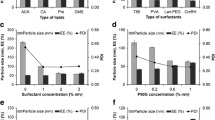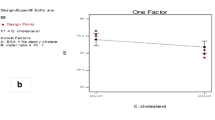Abstract
The main objective of the present work was to compare the transdermal delivery of salbutamol sulfate (SS), a hydrophilic drug used as a bronchodilator, from ethosomes and classic liposomes containing different cholesterol and dicetylphosphate concentrations. All the systems were characterized for shape, particle size, and entrapment efficiency percentage, by image analysis optical microscopy or transmission electron microscopy, laser diffraction, and ultracentrifugation, respectively. In vitro drug permeation via a synthetic semipermeable membrane or skin from newborn mice was studied in Franz diffusion cells. The selected systems were incorporated into Pluronic F 127 gels and evaluated for both drug permeation and mice skin deposition. In all systems, the presence of spherical-shaped vesicles was predominant. The vesicle size was significantly decreased (P<.05) by decreasing cholesterol concentration and increasing dicetylphosphate and ethanol concentrations. The entrapment efficiency percentage was significantly increased (P<.05) by increasing cholesterol, dicetylphosphate, and ethanol concentrations. In vitro permeation studies of the prepared gels containing the selected vesicles showed that ethosomal systems were much more efficient at delivering SS into mice skin (in terms of quantity and depth) than were liposomes or aqueous or hydroalcoholic solutions.
Similar content being viewed by others
References
Touitou E, Dayan N, Bergelson L, Godin B, Eliaz M. Ethosomes—novel vesicular carriers for enhanced delivery: characterization and skin penetration properties.J Control Release. 2000;65:403–418.
Kirjavainen M, Urtti A, Jaaskelainen I, et al. Interaction of liposomes with human skin in vitro—the influence of lipid composition and structure.Biochim Biophys Acta. 1996;1304:179–189.
El Sayed MA, Abdallah OY, Naggar VF, Khalafallah NM. Deformable liposomes and ethosomes: mechanism of enhanced skin delivery.Int J Pharm. 2006;322:60–66.
Cevc G, Blume G. Lipid vesicles penetrate into intact skin owing to the transdermal osmotic gradients and hydration force.Biochim Biophys Acta. 1992;1104:226–232.
Honeywell-Nguyen PL, Bouwstra JA. Vesicles as a tool for transdermal and dermal delivery.Drug Discov Today. 2005;2:67–74.
Benson HA. Transfersomes for transdermal drug delivery.Expert Opin Drug Deliv. 2006;3:727–737.
Oh YK, Kim MY, Shin JY, et al. Skin permeation of retinol in Tween 20-based deformable liposomes: in-vitro evaluation in human skin and keratinocyte models.J Pharm Pharmacol. 2006;58:161–166.
Trotta M, Peira E, Carlotti ME, Gallarate M. Deformable liposomes for dermal administration of methotrexate.Int J Pharm. 2004;270:119–125.
Cevc G, Blume G. Hydrocortisone and dexamethasone in very deformable drug carriers have increased biological potency, prolonged effect, and reduced therapeutic dosage.Biochim Biophys Acta. 2004;1663:61–73.
Ainbinder D, Touitou E. Testosterone ethosomes for enhanced transdermal delivery.Drug Deliv. 2005;12:297–303.
Paolino D, Lucania G, Mardente D, Alhaique F, Fresta M. Ethosomes for skin delivery of ammonium glycyrrhizinate: in vitro percutaneous permeation through human skin and in vivo anti-inflammatory activity on human volunteers.J Control Release. 2005;106:99–110.
Magnusson BM, Runn P, Karlsson K, Koskinen L. Terpenes and ethanol enhance the transdermal permeation of the tripeptide thyrotropin releasing hormone in human epidermis.Int J Pharm. 1997;157:113–121.
Lopez-Pinto JM, Gonzalez-Rodriguez ML, Rabasco AM. Effect of cholesterol and ethanol on dermal delivery from DPPC liposomes.Int J Pharm. 2005;298:1–12.
Godin B, Touitou E. Erythromycin ethosomal systems: physicochemical characterization and enhanced antibacterial activity.Curr Drug Deliv. 2005;2:269–275.
Godin B, Touitou E. Mechanism of bacitracin permeation enhancement through the skin and cellular membranes from an ethosomal carrier.J Control Release. 2004;94:365–379.
Kelly HW, Murphy S. Beta-adrenergic agonists for acute, severe asthma.Ann Pharmacother. 1992;26:81–91.
Hochhaus G, Mollmann H. Pharmacokinetic/pharmacodynamic characteristics of the beta-2-agonists terbutaline, salbutamol and fenoterol.Int J Clin Pharmacol Ther Toxicol. 1992;30:342–362.
Sweetman SC.Martindale: The Complete Drug Reference. London, UK: Pharmaceutical Press; 2005.
Holimon TD, Chafin CC, Self TH. Nocturnal asthma uncontrolled by inhaled corticosteroids: theophylline or long-acting beta2 agonists?Drugs. 2001;61:391–418.
Murthy SN, Hiremath SR. Clinical pharmacokinetic and pharmacodynamic evaluation of transdermal drug delivery systems of salbutamol sulfate.Int J Pharm. 2004;287:47–53.
Liang W, Levchenko TS, Torchilin VP. Encapsulation of ATP into liposomes by different methods: optimization of the procedure.J Microencapsul. 2004;21:251–261.
Sentjurc M, Vrhovnik K, Kristl J. Liposomes as a topical delivery system: the role of size on transport studied by the EPR imaging method.J Control Rel. 1999;59:87–97.
Kanikkannan N, Singh J, Ramarao P. In vitro transdermal iontophoretic transport of timolol maleate: effect of age and species.J Control Rel. 2001;71:99–105.
Guide for the Care and Use of Laboratory Animals #86-23. Bethesda, MD: National Institutes of Health; 1985.
Das MK, Bhattacharya A, Ghosal SK. Effect of different terpene-containing essential oils on percutaneous absorption of trazodone hydrochloride through mouse epidermis.Drug Deliv. 2006;13:425–431.
El Maghraby GM, Williams AC, Barry BW. Skin delivery of estradiol from deformable and traditional liposomes: mechanistic studies.J Pharm Pharmacol. 1999;51:1123–1134.
Warner RR, Myers MC, Taylor DA. Electron probe analysis of human skin: determination of the water concentration profile.J Invest Dermatol. 1988;90:218–224.
Lasic D, Weiner N, Riaz M, Martin F. Liposomes. In: Lieberman A, Rieger M, Banker G, eds.Pharmaceutical Dosage Forms: Disperse Systems. vol 3. New York, NY: Marcel Dekker; 1998:43–86.
Barry AL, Cullis PR. Direct NMR evidence for ethanol binding to the lipid-water interface of phospholipid bilayers.Biochemistry. 1994;33:8082–8088.
Maurer N, Wong KF, Stark H, et al. Spontaneous entrapment of polynucleotides upon electrostatic interaction with ethanol-destabilized cationic liposomes.Biophys J. 2001;80:2310–2326.
Kulkarni SB, Singh M, Betageri GV. Encapsulation, stability and in vitro release characteristics of liposomal formulations of colchicine.J Pharm Pharmacol. 1997;49:491–495.
El-Samaligy MS, Afifi NN, Mahmoud EA, Afify NN, Mahmoud EA. Increasing bioavailability of silymarin using a buccal liposomal delivery system: preparation and experimental design investigation.Int J Pharm. 2006;308:140–148.
El Sayed MA, Abdallah OY, Naggar VF, Khalafallah NM. Lipid vesicles for skin delivery of drugs: reviewing three decades of research.Int J Pharm. 2007;332:1–16.
Honeywell-Nguyen PL, Bouwstra JA. The in vitro transport of pergolide from surfactant-based elastic vesicles through human skin: a suggested mechanism of action.J Control Release. 2003;86:145–156.
Cevc G. Lipid vesicles and other colloids as drug carriers on the skin.Adv Drug Deliv Rev. 2004;56:675–711.
Author information
Authors and Affiliations
Corresponding author
Additional information
Published: December 14, 2007
Rights and permissions
About this article
Cite this article
Bendas, E.R., Tadros, M.I. Enhanced transdermal delivery of salbutamol sulfate via ethosomes. AAPS PharmSciTech 8, 107 (2007). https://doi.org/10.1208/pt0804107
Received:
Revised:
Accepted:
DOI: https://doi.org/10.1208/pt0804107




